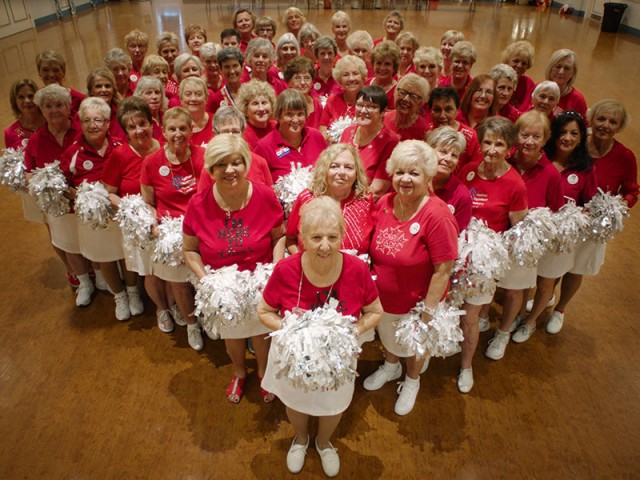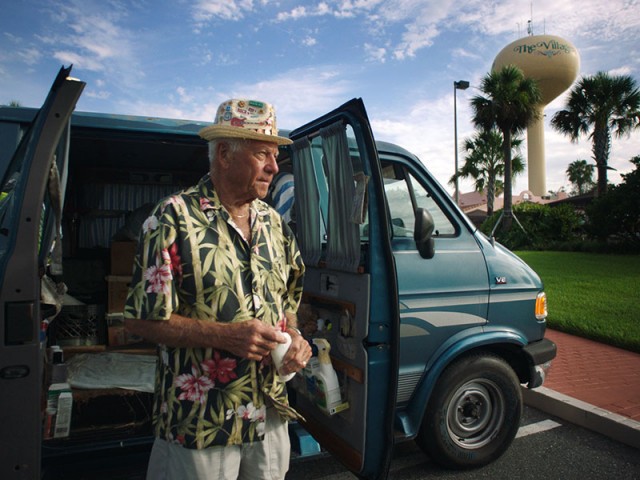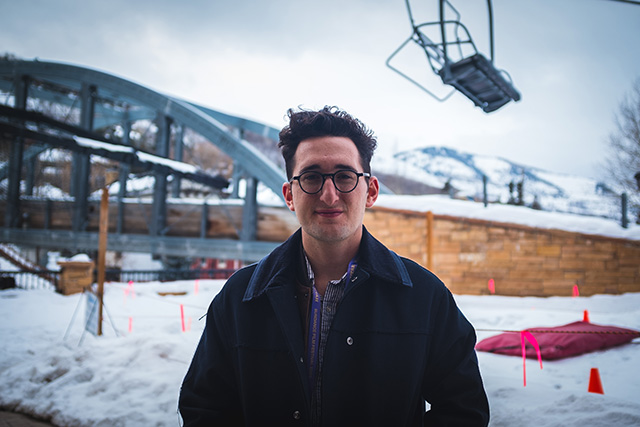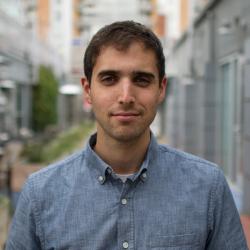I’ve been following and writing about the documentary work of filmmaker Lance Oppenheim since he was 17. Yes, you read that right, 17. He’s now the ripe-ole age of 24…
I don’t say that to make you feel unaccomplished (well, maybe I do…a little), but more to put some perspective on Oppenheim and his filmmaking journey. Starting with an emotional tribute to his grandfather in the wake of Alzheimer’s to his multi-layered human profiles of diverse people from all walks of life, he has an inherent knack for finding compelling documentary protagonists and using their specific, personal stories to tell broader narratives with larger themes.
At this year’s Sundance, he makes the jump to features, premiering Some Kind of Heaven, which chronicles the lives of the residents of America’s largest retirement community: The Villages, Florida.
I had the opportunity to sit down in Park City and talk with Oppenheim about his short films, his impressive (yet still young) career, and the process and story behind Some Kind of Heaven, which, through the broader framing of this uncanny retirement community, becomes a poetic rumination on the universal wants and desires that affect us all, no matter our age.

You’ve been making polished short docs since you were literally 17. How do you contextualize your journey, as you started so young? How did you know you were ready to make the jump to a feature?
Well, I didn’t go into it thinking I was going to make a feature. With each short, it was really just like a bow and arrow I had in my arms, but I didn’t know where the target was. I knew the setting was interesting…I knew the story was interesting. So, I fired the arrow, and then, I would try to chase where that target was by the time I finished the film. This feature was different because I think it’s hard to boil down someone’s essence as a human being if you’re only with them for days. To do that in 10 minutes, oftentimes, you get more close to the work itself than you do the people. With this movie, I feel like it goes a lot deeper than a lot of the work I’ve done.
Can you explain logistically how it worked out? I know you’ve made several profile docs, some of which were released via the New York Times Op-Docs Series. Is this a natural progression of that partnership? Was the New York times on board from the get-go for Some Kind Of Heaven or did you just start just filming material and their involvement came later?
It was the latter. I think part of it too is from your platform and Staff Picks and everything else. I was always just growing up: I wanted to make stuff and I wanted people to watch the stuff I made. On Vimeo, I remember looking at all the channels and seeing that the curators were looking at these channels, and from there, they’d choose something. I remember just spamming the people who would run these channels and try and get the shorts as much play as possible. With Op-Docs, I thought it was a natural extension of the work that Short of the Week does, where you’re finding and curating cool short films. I was attracted to Op-Docs because they had a huge platform. Also, the other part of it is that I really enjoy working with them. The people there never really dictated a set way of making things. They like when you bring something to the table that is different. I feel like all the shorts that I did with them were better for their involvement.
Would you come to the New York Times with the films already complete?
For Long Term Parking, I came to them with a mostly completed doc, and then, they had notes. For some filmmakers, it’s hard to take notes. But, for me, I really benefit, from having people who are critically engaged with something, trying to make it better. So, for Long Term Parking, I came to them with something that was mostly completed. The second film I did with them, No Jail Time, was something that they really helped to shape. I had a lot of material that I was shooting and they had a lot of notes which helped the film progress.
Did they connect you with that film’s protagonist?
No, I’d always find this stuff on my own and then I would basically always bring it to them. They never even give me money to make this stuff. That is a really gracious doc producer named Maida Lynn who worked with Ivete Lucas and Patrick Bresnan (Pahokee and Rabbit Hunt). She was a supporter of a lot of the shorts I made without really asking for anything in return. Also, being in college, I was able to get a lot of resources from school and use that as a way to get films made. I would work on them concurrently, and then, find a home for them after.
“You still have to hustle with every film.”
Honestly, what you’re saying is very inspiring to me personally because it kind of proves that there is no free lunch, in a sense. It’s not like you suddenly got connected with The New York Times, and all of a sudden, it was smooth sailing.
Yeah. You still have to hustle with every film.
You mentioned that Some Kind of Heaven developed into a feature as you were working on it. Was there a specific moment when you knew in your head that was going to happen?
After the end of the first shoot, there was a whole different storyline that I thought was going to be the crux of the film. Truthfully, I really did put the cart before the horse! I knew that the setting was really interesting. I had found really interesting characters, but there wasn’t a story yet.The New York Times expressed interest, but they weren’t footing the bill or anything. Again, I was thinking this would maybe become another Op-Doc or something. Initially, the idea was to make a short film and then garner enough interest to raise some money to make a feature. But, then I was just like: why don’t I just do it now, even if I don’t actually have a clear cut idea of what this is going to germinate into? Why not just try? So, I cut together, like, a sizzle reel.
At the end of the first shoot, which was around 30 days, I think everyone felt that there was something there, but we would have to keep coming back to figure it out. We got really lucky in a lot of ways. It was the right group of collaborators. The New York Times was willing to take a chance on something new. Darren (Aronofsky is a producer on the film) was someone whose email I had been spamming for a long time. He had seen a few of my Op-Docs, so he was also willing to take a chance. And, then, the financiers of the film, The Los Angeles Media Fund had done a few docs before and came in to help out. I think everyone was basically willing to go along for the ride and just trust that it would work itself out.
“The people in this film—the problems that they’re going through—are not funny to me. I think they’re inspiring.”

One of the things about Some Kind Of Heaven—and I think it’s common with your shorts as well—is an absurdly comedic tone. But, at the same time, you’re not making fun of the characters. Can you kind of talk about striking that balance between entertainment and empathy?
That’s a good question. It’s a tightrope, right? I think a big part of it to me is the people in this film—the problems that they’re going through—are not funny to me. I think they’re inspiring. The thing that’s interesting is the contrast between real people going through real problems and then it’s all set in this very fake, fantastical place. There’s a lot of inherent comedy in that contrast. That’s something that Daniel Garber, the editor of the movie, and I really had to work on, as we’re young filmmakers making a film about people who—in some cases—we are three generations removed from. How can we look at these people not as old people but just as people? There’s nothing easier in a documentary to just make someone look absurd or stupid. I don’t think that’s interesting. When I see films that do that, I’m not impressed by them and I don’t find them funny. Hopefully, how the movie plays…it’s not at the expense of the characters.
Another link between the feature film and shorts is this profound sense of longing and melancholy. Is this something you’re consciously aiming for when crafting your films? Or, does it just kind of happen along the way?
I don’t know exactly. I think there’s a gut instinct I have. I talked to a lot of people…you just have to be curious enough to see what’s going on in people’s lives. The key thing in the film is anyone who lives in The Villages could be going through the exact same issues, even if they aren’t to the extreme. Maybe not everyone has a husband like Reggie or maybe not everyone is on the lamb for a DUI. But, everyone—in some way, shape, or form—has this unresolved desire in them. I personally have that all the time. How can you relate? How do you find things that are relatable in a world that is so foreign to you? That’s something that I’m always trying to get towards.

Oppenheim in Park City, Utah — January 2020
I’m just really curious about how the logistics for a film like this work. Do you come out to this place and just show up with a camera? Did you just go to the main office and say: “I’d like to make a documentary about this place?” And they’re like: “Cool! Go for it!”
Ha ha. Well, the beauty of the place having these public roads is that anyone can come in. So, I just showed up and I lived in a rented Airbnb room with these retired rodeo clowns. They showed me around and gave me a lay of the land. I knocked on people’s doors, made phone calls…I sometimes would do background checks to get people’s phone numbers. I bought a Villages phone book and just kind of showed up. A big part of it is that I show up without a big camera crew. I gave myself probably about 28 days alone…just being there. I did have a little DSLR on me, so I was always upfront about my intentions that I was making a documentary film. I told them I wasn’t sure what it was about, but that I was curious and I wanted to learn stuff about the place.
I feel like it’s a testament to my crew, too. Beyond being an excellent cinematographer, my DP, David Bolen, has a very beautiful way of interacting with people. Some cinematographers, especially in documentary, have excellent technical skill and can compose a really good shot, but aren’t as good with people. David can do both. Along those lines, people at the Villages were willing to work with us because my crew was genuinely interested in who they were. There were so many days where I had no idea what we were shooting or why we were shooting it—and likely didn’t make it into the film—but, everyone was just down for the ride and they were always trying to find interesting ways to frame things.
When did it become clear which particular residents would make up the foundation of the movie?
After the second shoot it was becoming more clear to us— the outline of what the movie could be. But, the film didn’t start out that way. The reason I came initially was that I was interested in the institutions of the place. I was interested in the ways in which their own newspaper, which only prints the good news, worked. I was interested in the inner workings of the community and I got denied access. I couldn’t do that film. Every time I attempted shooting guerrilla versions of it, it just wasn’t really working. We shot with a lot of subjects, and I think the reasons in which these folks are in the film and the reasons why the film is concerned with these people is because, for one, we just happened to be there in some very intense and intimate times, and they were vulnerable enough to let us in. I think it really did speak to this underlying thematic idea: even though you may be older you still are just as filled with desire as you were when you were younger.
“The thing that I learned very quickly is that setting isn’t story, especially in a feature.”
So, going into it—in your head—you’re like: “I’m going to make a movie about this Boomer Bubble”: a place where people have basically chosen to hide from the complexities of the world in favor of this idyllic fantasy in the latter part of their lives. Then, you made the choice to be like: “no, this is a story about people and longing and their personal stories.”
I’d say that’s an accurate trajectory. It was the setting that drew me there. I think the thing that I learned very quickly is that setting isn’t story, especially in a feature. Maybe in a short you can get away with just making a kind of a carnival show—a slide show of interesting kooky characters. That wasn’t the most interesting way to make the movie. Yeah, the movie does take place in this really wacky world, and, hopefully, there are still elements of what the place is and why it’s still relevant to the main stories. Ultimately, though, what’s interesting to me is trying to articulate the struggles of the people who live inside this place and see the place through their perspectives.
I want to talk about voice, especially in documentary. Most docs I watch, especially short profile docs, feel very derivative to me stylistically. I feel like your films—from your shorts to this feature—have a very defined sense of voice. Did you have to hone that style or is it just something that kind of came naturally to you?
It always comes back to the setting, right? On the cruise film, the idea was: how do you capture that fantasy? How do you inhabit the fantasy that he lives in? On that film, I was working with a really great DP named Nate Hurtsellers and we used a Steadicam to produce really smooth gliding shots that kind of mimic the waves. On this film, the place is so manicured and perfect. How can we mimic that on screen? Also, how can we make this feel almost like a throwback to the generation we are filming—the movies that these subjects would have watched…like the Turner Classic Movies, which is why we shot it in 4×3.

“I couldn’t steal shots. We’re not flies on the wall. We’re documenting things that happen in their everyday lives.”
I don’t really have a question, but I just wanted to say that one of my favorite aspects of the film was how well-framed every shot is. Every shot looks like it could be a still photograph that you’d want to hang on your wall.
Thank you. Yeah, I think that’s the other thing too: you see a lot of movies that have a lot of sauce and there’s not as much going on under the hood. I think this movie could have easily fallen into that trap. But, the style—the overly stylized way we were shooting things and how composed everything was—was very instructive in some ways to my dynamic with the subjects in the film. I couldn’t steal shots. We’re not flies on the wall. We’re documenting things that happen in their everyday lives. It’s documentary. I’m not saying it’s like fiction or anything like that, but I don’t shy away from asking tough questions and I don’t shy away from asking to film in tough locations. So, I think a large part of it is that if we hadn’t shot with such an artifice, I don’t think we would have gotten to the real emotional truth that is in the movie. Hopefully, it also speaks to the dynamic of the Villages as well, which is a very fake place with very real things going on underneath it.
“When you’re making a profile doc…you need to find a perspective on it that maybe others don’t have.”
As we’re a short film website, I have to ask: what would be your advice to documentary short filmmakers? What does it take for a short profile doc to stand out in the current crowded landscape?
Before I get to the “standing out” part of it, I think you really need to be your own MC. You need to fight to get your things viewed. I had like 50 Reddit accounts. I figured out what time it’s best to put something on r/videos. I would wake up at four in the morning and I would artificially bump stuff just to try and get people to look at it. Sometimes it works…sometimes it doesn’t…but you need to have that kind of hunger in your stomach to get people to watch stuff. One of the things that’s great about your website is that people look at it. People across the industry want to find new talent. They want to see who’s excited and hungry and looking to use the medium in an entertaining way. When you’re making a profile doc or you’re making something that is concerning a subject that may not have a clear cut storyline, you need to find a perspective on it that maybe others don’t have. I think that comes from talking with your subject for a really long time. I think it requires you to use your brain before you start thinking about how you’re going to depict what that looks like. I think you need to find yourself in the stories of other folks, and I think you need to find a perspective that is interesting enough to justify why you’re making it. It has to have two levels.
“I certainly have seen a lot of shorts that privilege sauce and style over content.”
Let’s say you’re making a film about…I don’t know…a guy who collects birds. On its face, it’s a movie about a guy who collects birds, but what is underneath that? What is it actually about? What is it saying? I certainly have seen a lot of shorts that privilege sauce and style over content. I think that is annoying. Why don’t you just shoot a music video? Think very critically about what you’re doing and then let the style emerge from the subject.
Is there anything else you wanted to add?
I just wanted to say, on the record, I would not have been able to get to Op-Docs without you all…they only took me seriously because I had a few films on Short of the Week as well as being Staff Picked on Vimeo. Then, all of it was building on top of each other and I think I wouldn’t have gotten Darren’s attention, for example. I appreciate you, man. You really did help build what I’m doing now.
Thank you!
Some Kind of Heaven recently played at the 2020 Sundance Film Festival. For more information on Lance Oppenheim, visit his website.
 Ivan Kander
Ivan Kander